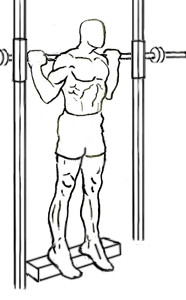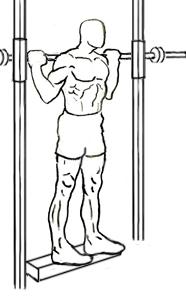Last Updated on September 27, 2014
The Smith Machine Reverse Calf Raise is an often-overlooked but highly effective exercise that targets the tibialis anterior, a critical muscle in the front of your lower leg. While traditional calf exercises focus on the posterior muscles, such as the gastrocnemius and soleus, the reverse calf raise strengthens the tibialis anterior, contributing to better balance, improved ankle stability, and reduced risk of shin splints.
In this in-depth guide, we’ll explore the benefits of the Smith Machine Reverse Calf Raise, provide detailed instructions for perfecting your form, discuss common mistakes to avoid, and offer variations and tips to maximize your results. Whether you’re an athlete looking to improve performance or simply want to strengthen your lower legs, this exercise is an excellent addition to your routine.
Why Should You Do Smith Machine Reverse Calf Raises?
Most people focus on the back of the calves during their workouts, neglecting the tibialis anterior, which is crucial for overall lower-leg strength and functionality. Here’s why incorporating Smith Machine Reverse Calf Raises into your routine is a game-changer:
1. Strengthens the Tibialis Anterior
This exercise isolates and strengthens the tibialis anterior, improving lower-leg balance and stability.
2. Enhances Ankle Mobility
By strengthening the muscles around the ankle, it enhances mobility and reduces the risk of injuries.
3. Prevents Shin Splints
Runners and athletes prone to shin splints will benefit greatly from strengthening the tibialis anterior, as it plays a key role in supporting the shinbone.
4. Improves Aesthetic Balance
Well-developed tibialis anterior muscles contribute to a balanced, symmetrical appearance in the lower legs.
5. Supports Athletic Performance
Strong tibialis anterior muscles improve dorsiflexion (the ability to lift the toes toward the shin), which is critical for running, jumping, and walking.
Muscles Worked
The Smith Machine Reverse Calf Raise primarily targets the tibialis anterior but also engages stabilizing muscles in the lower leg and foot:
- Primary Muscle:
- Tibialis Anterior (Front of Lower Leg)
- Supporting Muscles:
- Gastrocnemius (Back of Calf)
- Soleus (Deeper Calf Muscle)
- Foot Stabilizers
How to Perform the Smith Machine Reverse Calf Raise
Step-by-Step Instructions
Follow these detailed steps to ensure proper form and maximize the effectiveness of the exercise:
1. Set Up the Equipment
- Position a block, step, or low box under the Smith Machine.
- Adjust the bar on the Smith Machine to shoulder height, ensuring it’s easy to lift and secure.
2. Position Yourself
- Stand on the block with the front half of your feet hanging off the edge.
- Position the bar across your upper back, resting on your traps, and ensure it is secure before starting.
3. Grip the Bar
- Use a wide, overhand grip to stabilize the bar.
- Keep your chest up and back straight, engaging your core for stability.
4. Initiate the Movement
- Lean slightly forward and lift your toes upward by flexing your ankles. Your heels will naturally move downward as your tibialis anterior engages.
5. Lower to Starting Position
- Slowly lower your toes back to the starting position, allowing them to extend over the edge of the block.
- Maintain control throughout the movement to ensure a full range of motion.
6. Repeat
- Perform the desired number of repetitions with slow, controlled movements to maximize muscle activation.
Tips for Proper Form
- Control the Movement
Avoid jerking or bouncing during the exercise. Controlled movements are essential for isolating the tibialis anterior. - Engage Your Core
Keep your core tight to stabilize your torso and prevent unnecessary strain on your lower back. - Focus on Range of Motion
Allow your toes to fully extend downward and lift them as high as possible to maximize muscle activation. - Maintain a Neutral Spine
Keep your back straight and avoid leaning too far forward. - Start Light
Begin with a lighter weight to perfect your form before progressing to heavier loads.
Common Mistakes to Avoid
To get the most out of this exercise and reduce the risk of injury, avoid these common mistakes:
1. Using Too Much Weight
- Overloading the bar can compromise form and reduce the range of motion.
- Fix: Start with a manageable weight and gradually increase as your strength improves.
2. Leaning Too Far Forward
- Excessive forward lean places unnecessary strain on your lower back.
- Fix: Keep a slight forward lean while maintaining a neutral spine.
3. Neglecting Full Range of Motion
- Failing to fully lower and lift your toes limits the effectiveness of the exercise.
- Fix: Focus on slow, controlled movements through the entire range of motion.
4. Rushing Through Reps
- Performing reps too quickly reduces time under tension and minimizes results.
- Fix: Slow down your tempo to ensure proper muscle engagement.
Variations of the Smith Machine Reverse Calf Raise
Adding variations to your routine can target different aspects of the tibialis anterior and improve overall lower-leg strength:
1. Bodyweight Reverse Calf Raise
- Perform the exercise without the Smith Machine, using your body weight for resistance.
2. Seated Reverse Calf Raise
- Sit on a bench with a barbell or weight plate resting on your thighs and perform the movement.
3. Dumbbell Reverse Calf Raise
- Hold a dumbbell in each hand for resistance while standing on a block or step.
4. Single-Leg Reverse Calf Raise
- Perform the exercise one leg at a time to improve balance and target each tibialis anterior individually.
5. Tempo Reverse Calf Raise
- Slow down the lowering phase to increase time under tension and enhance muscle engagement.
Reps and Sets Recommendations
Your training goals will determine the ideal sets and reps for the Smith Machine Reverse Calf Raise:
- For Strength: 3–5 sets of 6–8 reps with heavier weight.
- For Muscle Growth (Hypertrophy): 3–4 sets of 8–12 reps with moderate weight.
- For Endurance: 2–3 sets of 12–15 reps with lighter weight.
Workout Integration
The Smith Machine Reverse Calf Raise can be included in various workout splits for maximum effectiveness:
1. Leg Day
- Pair it with exercises like squats, lunges, and calf raises for a comprehensive lower-body workout.
2. Functional Training
- Combine it with balance and stability exercises like single-leg deadlifts and lateral hops to improve overall athleticism.
3. Rehabilitation Routine
- Use it in a lower-intensity program to strengthen the tibialis anterior and prevent shin splints.
Benefits Beyond Aesthetics
The Smith Machine Reverse Calf Raise offers several functional benefits that extend beyond muscle definition:
1. Improved Balance and Stability
Strengthening the tibialis anterior enhances ankle and foot stability, reducing the risk of falls and injuries.
2. Enhanced Athletic Performance
Better dorsiflexion translates to more powerful strides, quicker direction changes, and improved jumping ability.
3. Shin Splint Prevention
Runners and athletes prone to shin splints benefit from the strengthened tibialis anterior, which reduces stress on the shinbone.
4. Better Posture
Strong lower-leg muscles support proper alignment and reduce strain on the knees and hips.
Safety Considerations
- Warm Up
Perform light cardio and dynamic stretches for your calves and ankles before starting. - Check Equipment
Ensure the Smith Machine is functioning correctly and the block or step is stable. - Progress Gradually
Start with lighter weights or body weight to avoid overloading the tibialis anterior. - Listen to Your Body
Stop immediately if you feel pain or discomfort and consult a fitness professional if needed.
FAQs
1. Is the Smith Machine Reverse Calf Raise suitable for beginners?
Yes! Beginners can start with lighter weights or body weight to learn the movement and build strength gradually.
2. How often should I do this exercise?
Incorporate it 1–2 times per week as part of a lower-body or functional training routine.
3. Can it prevent shin splints?
Strengthening the tibialis anterior with this exercise can reduce the risk of shin splints by supporting the shinbone during high-impact activities.
Conclusion
The Smith Machine Reverse Calf Raise is a unique and highly beneficial exercise that targets the tibialis anterior, a crucial yet often neglected muscle in the lower leg. By incorporating this movement into your routine, you’ll build stronger, more balanced lower legs, improve athletic performance, and reduce the risk of common injuries like shin splints.
Follow proper form, start with manageable weights, and gradually progress to heavier loads for maximum results. Whether you’re an athlete or simply looking to strengthen your calves, the Smith Machine Reverse Calf Raise is an excellent addition to your training arsenal.







